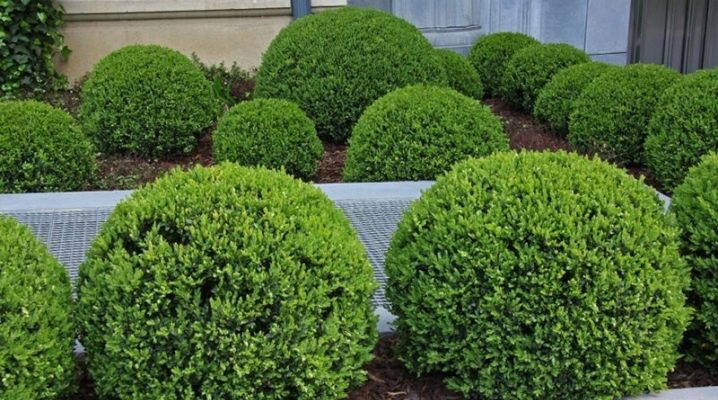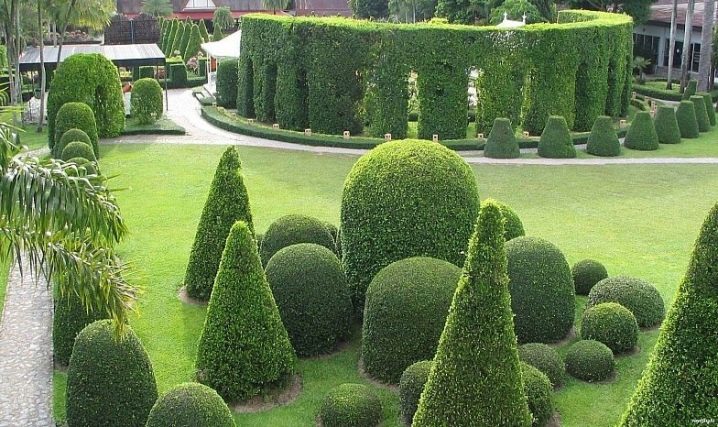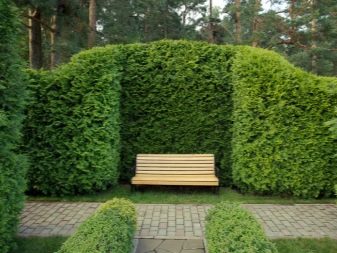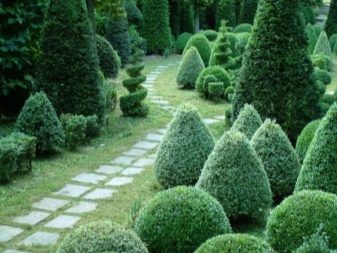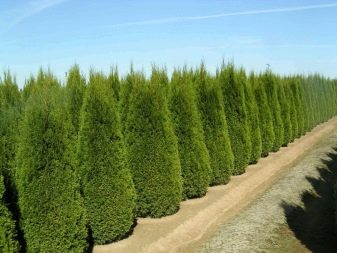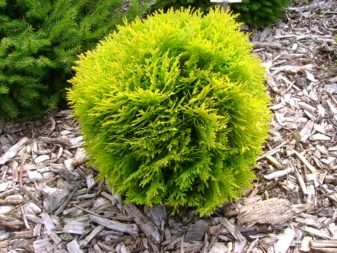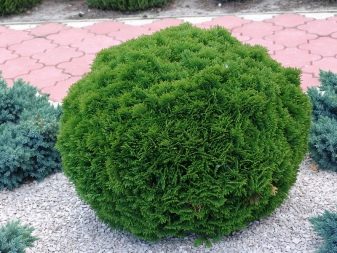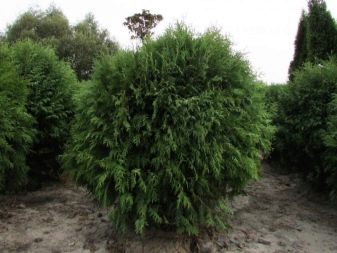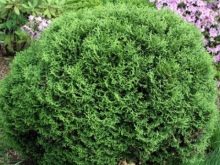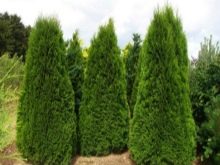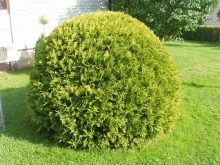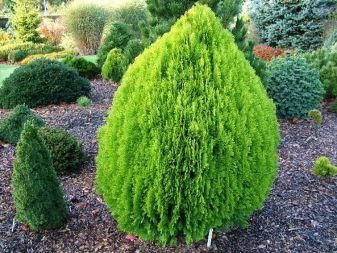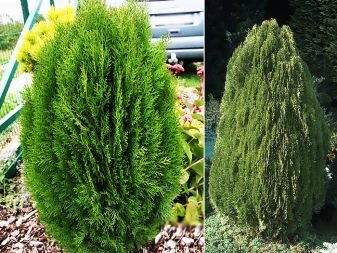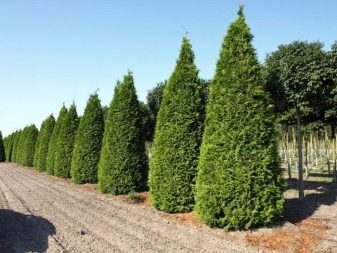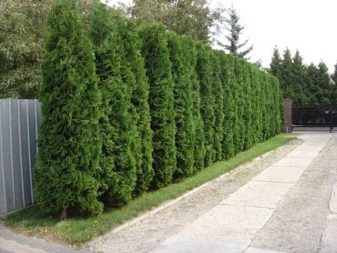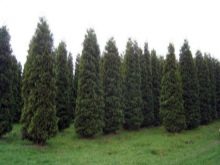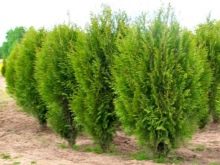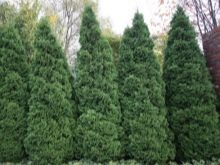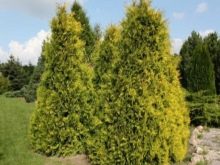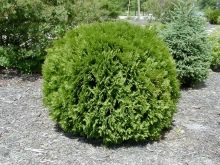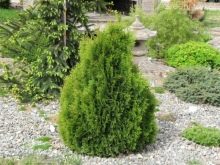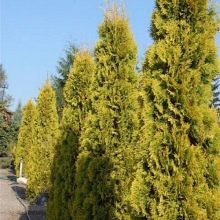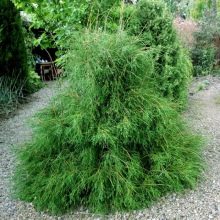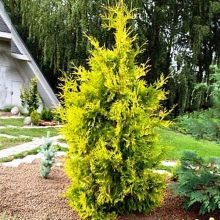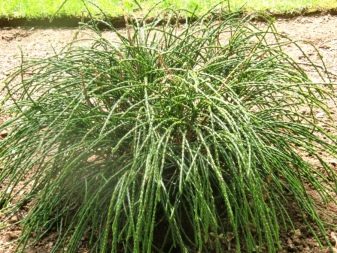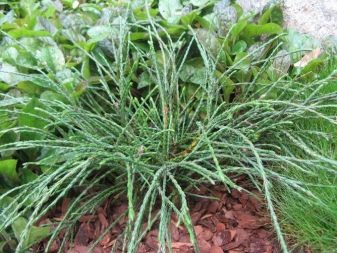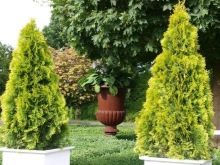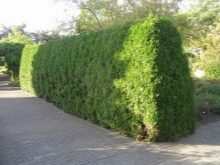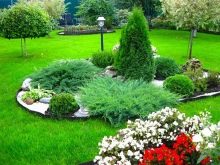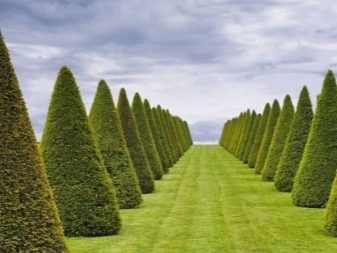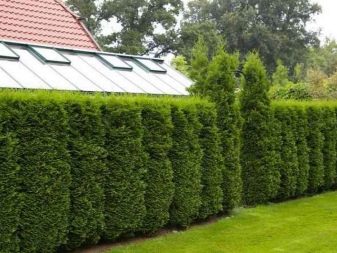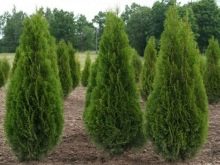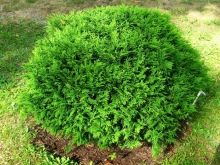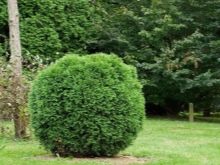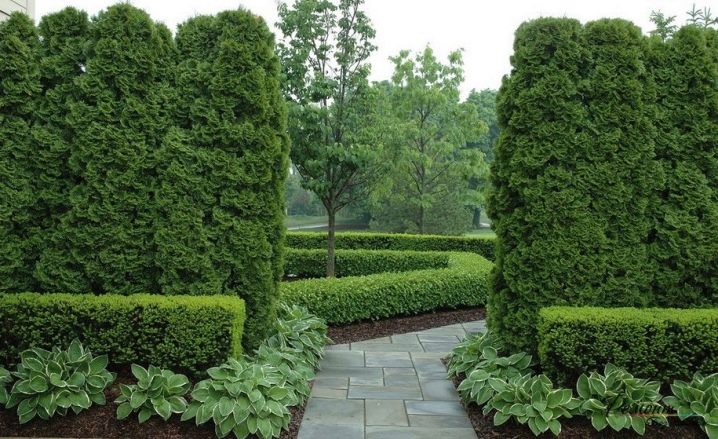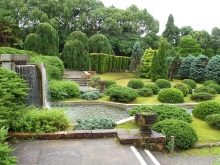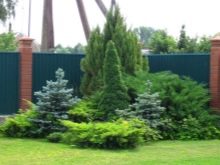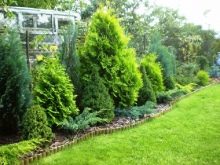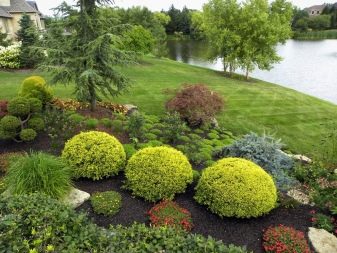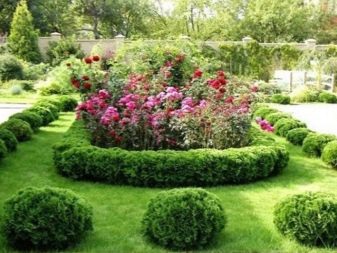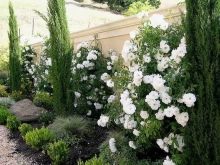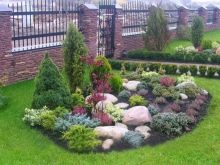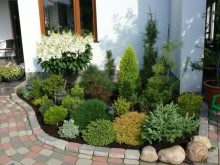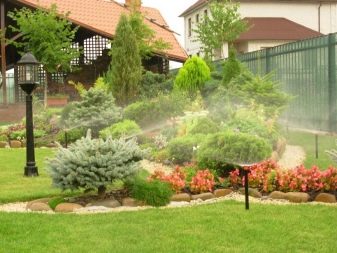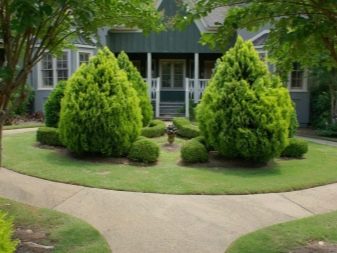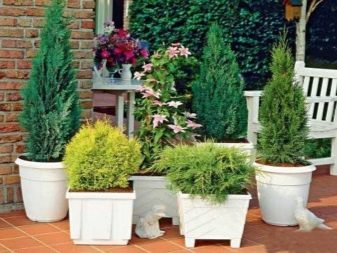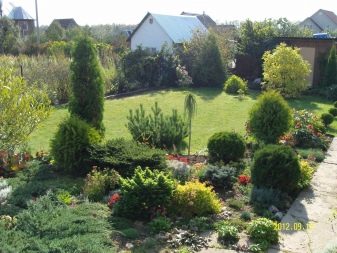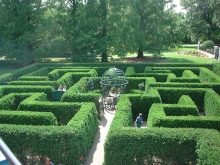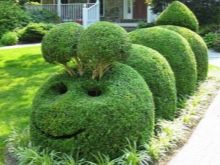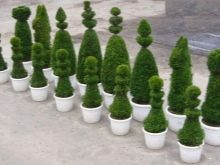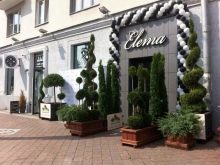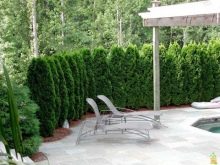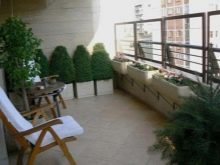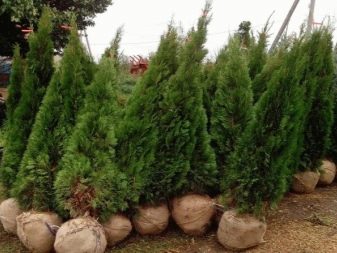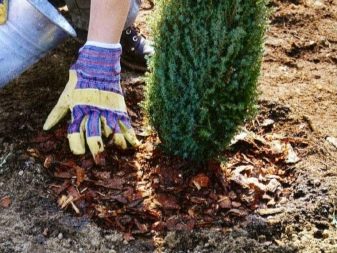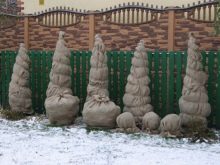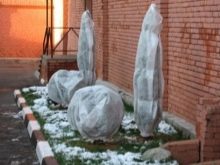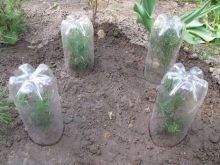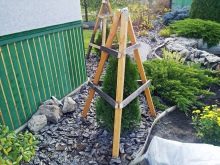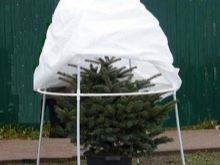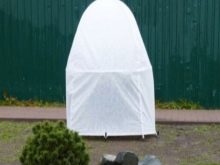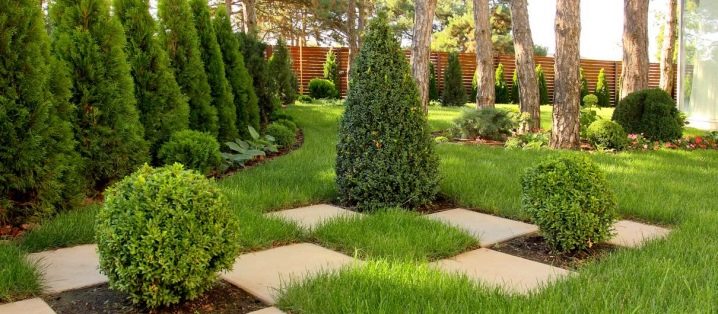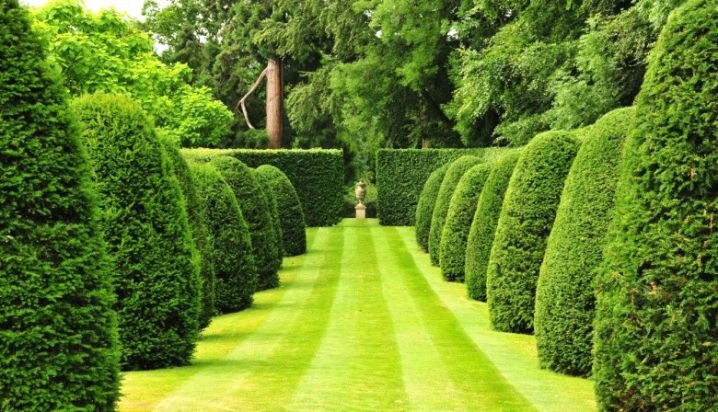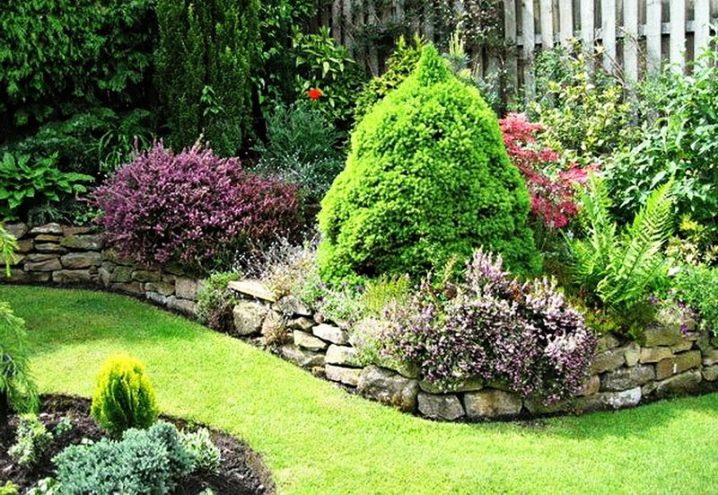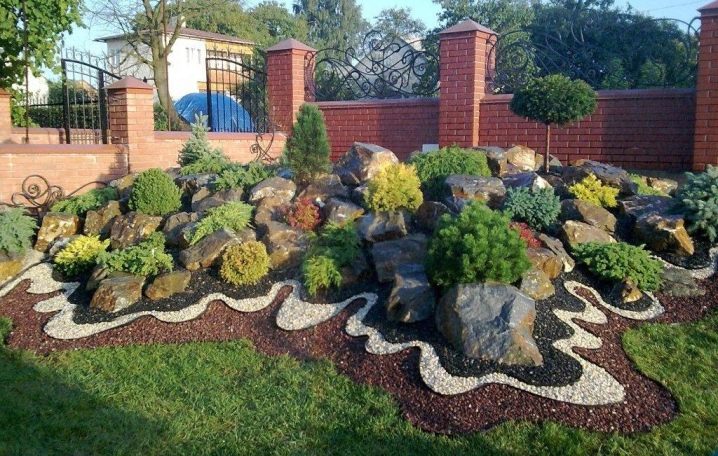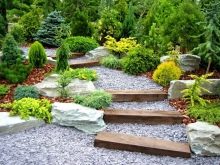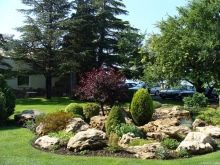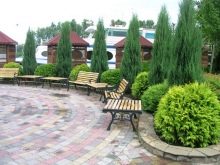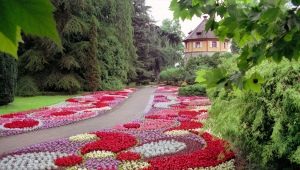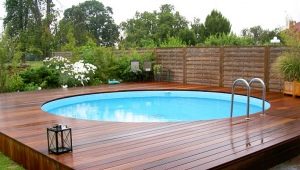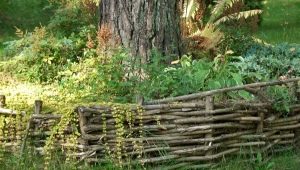Toui in landscape design: varieties and rules of care
For those who are fond of landscape design, an important point will be the use of Tui, which gives a special look to the backyard plot, cottage or private house. Depending on the variety, it can be used in different zones and linked with different plants. The rules for caring for thuja will allow this plant to please for many years with its bizarre forms and bright green twigs.
Features and benefits
Thuja is an evergreen plant that feels great in a temperate climate, without strong heat and frost. You can grow it in a variety of places, the main thing is to know the requirements of the variety in order to be able to properly care for it.
Since the plant is decorative and does not bear any other functions, the use of its one-sided - is the creation of landscape design.
Depending on the variety, the thuja can be represented by a small shrub a little more than half a meter, or it can be almost a full-fledged tree, growing up to two meters in height. Considering these features, it is possible to add some decorative elements on the site with thuisas or to plant them separately, so that they themselves serve as objects in landscape design.
Each variety has advantages and disadvantages. There are two types of tui: western and eastern, which are represented by different varieties.
Western variety:
- "Dannik" - This is a small plant, about 0.5 meters in height and width, but sometimes grows up to one meter to the side. Advantages: unpretentious care, growing in light loamy and sandy soils. Used as part of a design or as a single plant in a garden, it looks beautiful among flowers. Growth is slow, because the composition for a long time does not change its appearance. Of the minuses can be noted sensitivity to lack of water or excessive irrigation.
- "Globo" - This is a thuja, whose diameter is approximately one meter. Its advantage is the need for fertile and moderately wet soils.Fits very well into any design of the land. Among the drawbacks, it is worth noting the loss of form in old plants and the inability to grow normally in conditions of excessive moisture.
- "Khoseri" - medium-sized view of the Tui, whose diameter is 40 centimeters. The advantage is its size, because it works well on small plots of land, stone structures, in flower beds. The disadvantage is demanding the ground. It needs to be nutritious and always moderately watered.
- "Emerald" - it is a high grade of a thuja, its size can be from three to five meters. The crown is spread out not less than two meters on the sides. The advantage of the variety is the bright color of the needles. It tolerates not too severe frosts, can grow in relative shade, any fertile soil will be suitable for it. It grows best on calcareous rocks. The maximum lifespan is 150 years. Among the shortcomings it can be noted that due to the long absence of light, the color of the needles on the lower branches becomes less bright.
- Golden Globe. Diameter - about 80 centimeters. It grows well on fertile soils with moderate watering.It is used in compositions with a small number of elements or in flower beds. There is only one drawback - death during overwetting.
As for the eastern thuja, it is distinguished from such varieties:
- "Aurea Nana" - This is a medium-grown variety that grows to a height of no more than 80 centimeters. Of the benefits is to provide an oval-shaped crown, a golden hue of needles, which grows in a vertical direction.
Among the shortcomings can be noted the need for sheltered places and a winter shelter.
- "Justinka" - Thuja, whose height is about a meter. Advantages are the colonic shape and bright green color characteristics. Looks good in compositions with a limited number of elements. The disadvantages here are the same as in the previous variety - it suffers greatly from the wind and needs shelter for the winter.
Description and characteristics
Different types of thuja in different conditions manifest themselves in different ways. To know where it is better to plant, it is important to know the basic characteristics of each species. In total there are five: Korean, Western, giant, Japanese, Szechuan options.Only the western species grows well in our latitudes.
Its most popular varieties are:
- "Brabant" - a tree that can grow up to five meters in height, and reach a diameter of one and a half meters in diameter. This option is best suited for creating hedges. The annual growth of the tree is 30 centimeters high and 15 wide. Buy a seedling of this variety can only be in the nursery.
- Columna looks like a Crimean cypress. This is a huge tree, whose height reaches seven meters, and the crown in the diameter is spread out a little more than a meter wide. This variety can be used by those who want to recreate a Mediterranean style in their area.
- "Fastigiata" - It is also a tall variety of plant that can reach six meters in height. Apply most often as a hedge.
- "Wagnery" - These are tall trees that reach four meters in height. Frosty weather does not create difficulties for the bush, but now it perceives snowfall negatively. Feels best in open areas.
- Holmstrup - This is a tall variety of shrubs, reaching a height of two meters.The advantage is the presence of the correct cone shape. Most often it is planted among the trees. Bred, and sometimes grown in pots. Can be placed in a suitable flower garden. Disadvantages: does not tolerate weak soils, dies and fades on them. It reacts badly to drafts and also dies with them.
- "Sunikist" - It is a shrub from two to four meters in height. The shape of the crown is conical, and the color of the needles is yellow. Feels best in the sun. The growth process is very slow - it will be able to reach two meters only ten years after landing. Grow prefers on soils with good fertility and humidity. If there is no water, the crown is very thin.
- Woodwardy - It is a spherical bush. Its size is small, for ten years it grows up to half a meter, and then gradually changes its shape to a more elongated one.
- Mickey - a cone-shaped view of a thuja with a wide base and a pointed top. Its size is small, so you can grow a bush in round pots. Very hardy, can cope with any temporary difficulties. It grows in the sun or in the shade. The soil is suitable for any plant, but preference is given to loam without stagnant water.
- "Amber" - This is a relatively new plant, which is characterized by a bright yellow color of needles, which in the winter becomes amber. The maximum height is from three to five meters, by the age of ten it grows to about two meters with a crown of one meter. It grows slowly and adds no more than twenty centimeters per year. The soil should be characterized by such characteristics as weak acidity, good drainage. Plot is better to choose sunny.
- "Filiformis" - thuja, distinguished by its multiple leaves and needles of bright green color, as well as “Khozeri”. The maximum height can be two meters, and the diameter reaches the one and a half meter mark. Growth is slow. It grows on the ground of any type, but wet, drained, neutral loams are considered the most favorable. Grows in the sun or light partial shade.
- "Yellow Ribbon" - This is a plant with yellow needles. It has a conical shape. Two-meter size can reach no less than fifteen years. Grows in subacid and weak sod soil with peat and sand, as well as on clay and sand. Humidity should be normal. Because of its excess, the plant will die. It grows best in partial shade. It does not like drafts.
There is also a folded variation of Tui, which also has its own species, one of which is "Vipkord" - This is an ornamental plant of the cypress family. The maximum height can be about half a meter. Shoots are like ropes and have a spherical shape, from which the name of the plant. It grows too slowly - in ten years, the height is thirty centimeters. It grows in moist and well-drained soils in the sun and in partial shade.
In addition to the difference in variety, it is possible to distinguish tui also by their form, because each species has its own. In order to decorate rockeries, dwarf forms are better suited, as a hedge - higher varieties with a dense arrangement of branches.
For single landings or a small group, tall varieties are best suited.
The form of a thuja can be various. It is classified into five types:
- Pyramidal - Some of the plants grow to twenty meters, while others do not exceed two meters in height. Such species are planted separately or in a small group, combining with plants of various species.
- Kolonovidnaya - The height of such a plant is about five meters.It is used to create unusual fences, in the form of a living green wall and is distinguished by a large variety of varieties.
- Capstan - grows to two meters. Its branches are dense, which makes it possible with the help of this bush to form magnificent hedges.
- Umbrella - grows a small plant to one meter. It is often used as a decor for small flower beds.
- Spherical - This plant has very dense branches, which have a spherical shape. Growth is very slow. Over the entire period of life there is a change not only in size but also in the color of the needles.
For information on where and what kind of tui is best planted, see the next video.
What can be combined?
If you plan to fit into a landscape, then you need to know how to do it correctly and with what to combine it. It is recommended to plant this plant near playgrounds, schools, kindergartens, because as a shrub, like any coniferous tree, it produces phytoncides that help make the air cleaner.
The advantage of the thuja over the Christmas tree and the pine in this case is that their needles are soft, which is safe for the child.
Thuja in a spacious area or in a vast green landscape can grow as one, or in combination with other plants.In loneliness, large specimens are often planted, and those that are smaller can be attributed to the overall landscape. In order for you to get a beautiful plot, and the exterior had a complete appearance, it is important to consider the fact with which plants you combine thuja.
First of all, it must be plants that grow on the same soil. Thuy get along well with other conifers, grow well with spruces in the partial shade, grow next to low-growing mountain pines, and combine well with black pine in the sun.
Besides, thuja well complements and other flowering and deciduous bushes and treesamong which are florozia evopeyskaya, spirea “Vangutta”, barberry “Thunberg”, weigela hybrid, various roses, magnolia, apple-tree of Nedviedsky, potentilla “Kuril tea” and many other options. If you need to create a color extravaganza, then a good option would be to use spruce for this. Blue Glauka Globoza will contrast well with the bright green Smaragd or yellow varieties of thuja.
Conifers - thuja, cypress, juniper and others look very good with such colors as heather, white rose.
It is important to know that most conifers do not like to be close to larch, and this should be taken into account when planting. As for the location near the spruce, in these conditions both trees will suffer and will not be able to fully develop.
Design options
In order for your plot, private house or cottage to have an attractive appearance, it is important to ensure that all plants are in their places. For example, some varieties of thuja are characterized by thermophilicity and it is good when a large amount of sunlight falls on it. In this case disembarkation is important to do in open spaces, better in the form of single landings.
On the site you can combine different types of plants - small in pots, medium, are skillful in the composition in the garden among the flowers of different shades and sizes. In the country, the use of a large number of tall shrubs is impractical because they grow for a long time and take up a lot of space. It is better to land several options on the perimeter of the cottage so that they do not cover each other with the sun.
When planning to plant a thuja, it is important to prepare a pit under the tree, add compost to it and water it if necessary.The branches of young trees are not pruned so that they can form a strong and high crown. If you prune, instead of a tree will grow a bush. Some shrubs, on the contrary, can be cut and with the help of them you can create fancy shapes on the site.
Thuys are best suited for a variety of mixborders and rockeries. Alley or hedge from these bushes will be very beautiful. Western thuja in most cases all year round will please those who can see it. There are varieties with which you can originally arrange the terraces, balconies and loggias. To do this, you do not need to have a large capacity with the ground, and the cold, except for the strongest, they are not afraid.
How to store in winter?
If you have chosen to decorate your garden, which does not tolerate cold, then it will be important for her to move to the pot by winter and settle in a comfortable place. If the varieties are cold-resistant, then you need to take care that they have a supply of nutrients for the winter. To do this, the soil is dug up near the tree, a certain amount of fertilizer is poured into it, it all fits back under the trunk and is well covered with soil to the top so that the roots that are on the surface do not freeze.
It is important to cover not only the roots, but also the upper part of the plant.. For small bushes, you can also take bottles from under the water, in which they fit perfectly and will be warm and safe until spring. If your trees are older, you need to wrap them with kraft paper, gently pressing the branches against the trunk. Work is made from top to bottom with an overlap of ten centimeters. It is possible for the same purpose to use gauze half a meter wide, which is cut into pieces in the length of a shrub, tied on top and wound on a plant.
The latest innovations are specialized bags for plants, which can be easily used after wintering, leaching, drying and setting aside until the next cold.
For young trees, frames are often constructed on which cloth is put on. All this is designed to protect plants from strong winds, heavy snow, bright sunlight.
Beautiful examples on the landscape
If you want to diversify the landscape with the help of Tui, then you need to know where and how to insert this shrub. Consider the most interesting and unusual examples of the location of the Tui in the green zone.
You can only use different varieties of thuja in the street landscape, which will give an interesting composition.To create a clearer pattern, you can use pavement tiles, which will help to divide the space into a zone with grass and a zone with shrubs of different size and shape, as well as colors.
In the center of the territory, it is desirable to make some kind of composition, and along the edge there can be a living fence of high thujs.
If you are a lover of walking through your green zone, especially if it is also large, then it will be much nicer if there is lawn grass under your feet, neatly cut, and huge conical bushes of the same color and type will be located on both sides. It is possible to distinguish every corner of the territory with different varieties of Tui.
It will be very beautiful to design a flower bed using. Inside the flowerbed, it is important to arrange the plants in such a way that everything looks logical and correct. A riot of colors will be perfectly combined with bright green thuja. Flowers are better to choose those that are normally in the shape of a ball or semicirclethat will be combined with spherical shrubs.
An interesting option would be to use a composition with stones and various coniferous plants. The size of each object should be different and not repeated.Stones can be of different colors, textures and sizes, as well as thujas can have different colors, shapes and sizes.
